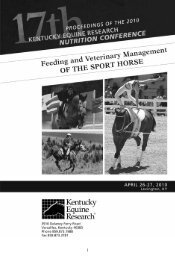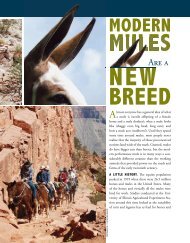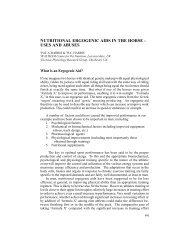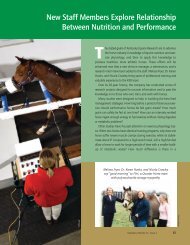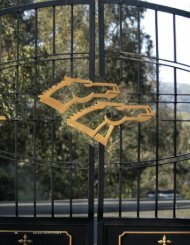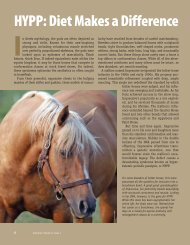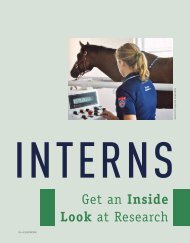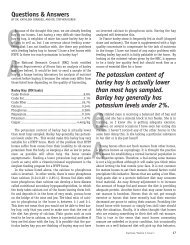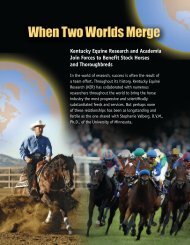Nutritional Management of Mares - Kentucky Equine Research
Nutritional Management of Mares - Kentucky Equine Research
Nutritional Management of Mares - Kentucky Equine Research
You also want an ePaper? Increase the reach of your titles
YUMPU automatically turns print PDFs into web optimized ePapers that Google loves.
P.J. Huntington et al. 193NUTRITIONAL MANAGEMENT OF MARES—THEFOUNDATION OF A STRONG SKELETONPETER J. HUNTINGTON 1 , ELIZABETH OWENS 2 , KATHLEEN CRANDELL 3 , ANDJOE PAGAN 31<strong>Kentucky</strong> <strong>Equine</strong> <strong>Research</strong> Australasia, Brighton, Victoria, Australia2Ridley AgriProducts PL, Wacol, Queensland, Australia3<strong>Kentucky</strong> <strong>Equine</strong> <strong>Research</strong>, Versailles, <strong>Kentucky</strong>, USAIntroductionThe impact <strong>of</strong> a broodmare feeding program can be substantial on the skeletaldevelopment <strong>of</strong> the foal and the equine athlete. Among domestic animals, horseshave the shortest period between parturition and rebreeding, and ideally the marewill be both lactating and pregnant simultaneously. Most horsemen have anappreciation for the obvious things that feeding affects such as fertility, milkproduction by mares, and the health <strong>of</strong> their foals. In recent years the importance<strong>of</strong> good nutrition during pregnancy has become more apparent. The goal <strong>of</strong> afeeding program for mares is to complement other facets <strong>of</strong> management so thattotal efficiency <strong>of</strong> the broodmare band is not compromised by nutrition and wastage<strong>of</strong> foals is minimized. One <strong>of</strong> the major causes <strong>of</strong> wastage is skeletal disease, andone <strong>of</strong> the most important periods for sound growth is the time prior to weaningwhen the foal is still nursing the mare. Studies <strong>of</strong> the incidence <strong>of</strong> osteochondritisdissecans (OCD) have shown that the disorder is very dynamic during the earlymonths <strong>of</strong> life and that the highest recorded incidence occurs at 5 months <strong>of</strong> age.Many foals are still not weaned at this age and are reliant on nutrition from mare’smilk, pasture and other forages, and concentrates from the mare’s feed bin orcreep feeder. Unfortunately, the pressures <strong>of</strong> the breeding season mean that manyfoals get more scrutiny and individual attention at or after weaning; by then,however, it may be too late.<strong>Mares</strong> should be divided into four classes when considering their nutritionalneeds: (1) the maiden mare; (2) the barren and early pregnant non-lactating mare;(3) the mare in the last third <strong>of</strong> pregnancy; and (4) the lactating mare (and possiblypregnant as well).Each <strong>of</strong> these classes <strong>of</strong> mares needs the same nutrients in the diet, but atdifferent levels <strong>of</strong> intake, as nutrient requirements are based on the physiologicalstate. In addition, foals within a breed vary in their metabolism and growth rateso they need to be fed differently. The contrast between the nutrient needs andfeeding practices required by Thoroughbred mares and warmblood mares isstriking. This paper will cover the important nutrient needs <strong>of</strong> different classes <strong>of</strong>mares and the feeding practices required in different management situations toachieve optimal nutrition for skeletal development.193
194 <strong>Nutritional</strong> <strong>Management</strong> <strong>of</strong> <strong>Mares</strong>Nutrient Needs <strong>of</strong> <strong>Mares</strong>ENERGY AND PROTEINThe requirements for energy and protein during pregnancy do not increasesubstantially until the last trimester <strong>of</strong> pregnancy, when 75% <strong>of</strong> the fetal growthoccurs (Table 1). There are very few studies to verify energy and proteinrequirements for mares, and more work is needed to clarify differences inrequirements between breeds. In other species, maternal malnutrition has beenshown to lead to long-term changes in metabolic processes in the <strong>of</strong>fspring. Couldthe performance potential <strong>of</strong> an equine athlete be influenced by intrauterine growthretardation that results from maternal malnutrition, disease, or reduced supply <strong>of</strong>nutrients to the fetus arising from placental or umbilical abnormalities? This topichas been covered in an excellent review article by Rossdale and Ousey (2002).Table 1. KER nutrient requirements <strong>of</strong> the 500-kg light horse broodmare 1 .Nutrient Early Late % Early % Latepregnancy pregnancy change lactation change lactationDE (MJ) 68 89 29 118 33 102Protein (g) 697 938 35 1414 51 1217Lysine (g) 24 33 38 50 52 43Calcium (g) 30 47 57 61 30 47Phosphorus (g) 20 31 55 41 32 31Magnesium (g) 10 12 20 15 25 12Zinc (mg) 337 450 34 600 33 500Copper (mg) 112 150 34 150 0 125Manganese (mg) 337 450 34 600 33 500Selenium (mg) 1.9 2.2 16 3 36 2.5Iodine (mg) 1.5 1.75 17 2.25 29 1.9Vitamin A (IU) 37500 43750 17 75000 71 62500Vitamin E (IU) 375 700 87 750 7 6251Light horses include Thoroughbreds, Standardbreds, Arabians, Quarter Horses, andsimilar breeds. Many mares are heavier than 500 kg, but this weight is used forcomparison purposes.<strong>Kentucky</strong> <strong>Equine</strong> <strong>Research</strong> (KER) has developed estimated nutrient requirementsfor warmbloods that take into account differences in metabolism and growth ratebetween light horses and warmbloods (Table 2). This table shows that warmbloodmares need less energy and protein and more minerals than light horse mares <strong>of</strong>the same weight.
P.J. Huntington et al. 195Table 2. Comparison <strong>of</strong> nutrient requirements <strong>of</strong> 500-kg Thoroughbred (TB) and 700-kgwarmblood (WB) mares during late pregnancy and early lactation.TB WB TB WBLate Late % Early Early %pregnancy pregnancy difference lactation lactation DifferenceWeight (kg) 575 800 40 500 700 40DE (MJ) 89 97 9 118 112 -5Protein (g) 938 1152 23 1414 1506 7Lysine (g) 33 40 21 50 53 6Calcium (g) 47 66 40 61 85 39Phosphorus (g) 31 44 42 41 57 39Magnesium (g) 12 17 42 15 21 40Zinc (g) 450 630 40 600 840 40Copper (mg) 150 210 40 150 210 40Manganese (mg)450 630 40 600 840 40Selenium (mg) 2.2 3.1 41 2 4.2 40Iodine (mg) 1.75 2.45 40 2.25 3.15 40Vitamin A (IU) 43750 61250 40 75000 105000 40Vitamin E (IU) 700 980 40 750 1050 40It is thought that during energy or protein deprivation pregnant and lactatingmares will draw upon stored reserves to maintain intrauterine growth <strong>of</strong> a fetusand milk production. During pregnancy, fetal growth is very slow during theearly months. By the end <strong>of</strong> the seventh month <strong>of</strong> pregnancy, the fetus has onlydeposited 10% <strong>of</strong> the protein it will contain at birth. In the last four months <strong>of</strong>pregnancy, the fetus will deposit about 8 kg <strong>of</strong> protein as it grows to a birthweight <strong>of</strong> 50 kg (protein deposited and birth weight will vary depending on breed).During the last month <strong>of</strong> pregnancy alone, the fetus will deposit over 2.5 kg <strong>of</strong>protein into its body. <strong>Mares</strong> produce large quantities <strong>of</strong> milk and this dramaticallyincreases demands for protein and energy. Milk production is estimated at between3 and 4% <strong>of</strong> body weight during the first 2 months <strong>of</strong> lactation, and this declinesto 2% <strong>of</strong> body weight after 5 months. Milk is 20-25% protein on a dry matterbasis.Gill et al. (1985) restricted mares to 70% <strong>of</strong> protein needs during pregnancyand lactation and found that birth weights were not affected, but growth rate <strong>of</strong>the foal to 90 days was reduced in the restricted group compared to mares fednormal diets during both pregnancy and lactation or those restricted duringpregnancy but not lactation. These diets were not isocaloric. This effect <strong>of</strong> proteindeprivation on the growth rate <strong>of</strong> foals was presumed to have occurred via aneffect on milk production. The quality <strong>of</strong> protein supplied to the lactating mare
196 <strong>Nutritional</strong> <strong>Management</strong> <strong>of</strong> <strong>Mares</strong>may influence milk production and growth rate. Glade and Luba (1990) addedsoybean meal to the diet <strong>of</strong> Thoroughbred mares being fed a high-proteinconcentrate 2 weeks prior to and 7 weeks after foaling. The addition <strong>of</strong> 500 g <strong>of</strong>soybean meal prior to foaling and 750 g after foaling was matched by a reductionin concentrate intake so that the DE intake remained the same in both groups. Thecrude protein content <strong>of</strong> milk was significantly increased in the first 5 weeks <strong>of</strong>lactation, and the foals <strong>of</strong> soybean-supplemented mares grew 10% taller in thefirst 7 weeks <strong>of</strong> life. The control group <strong>of</strong> mares in this study were fed a 16% (asfed) crude protein concentrate and were supplied with crude protein and lysine inexcess <strong>of</strong> National <strong>Research</strong> Council (NRC) requirements both before and afterfoaling. However, several studies have also shown that variations in protein andamino acid intake had no impact on the composition <strong>of</strong> mare’s milk.The impact <strong>of</strong> protein and energy restriction may depend upon the reserves themare has to draw on. Pagan et al. (1984) found that there was no difference in thegrowth rate <strong>of</strong> pony foals on mares that were fed either 70% or 130% <strong>of</strong> theirenergy and protein requirements. <strong>Mares</strong> either lost or gained weight, but foalgrowth rate did not change. However, when mares were in poor body condition (abody condition score <strong>of</strong> 2) and had fewer reserves to draw on for the energy andprotein required for milk production, growth rate <strong>of</strong> the foal was reduced. Thesame group <strong>of</strong> researchers found that feeding excess energy to pony mares led toreduced fat and protein content in the milk, which might reduce growth rate.Doreau and Boulet (1987) found that thin mares had lower milk production thanfat mares.Adding 5% fat to the diet <strong>of</strong> lactating mares led to an increase in milk energyproduction (Davison et al., 1991). H<strong>of</strong>fman et al. (1996) found that mares fed ahigh-fat, high-fiber concentrate prior to and after foaling had higher levels <strong>of</strong>linoleic acid in their milk than mares fed a high-starch, high-sugar concentrate.This increased linoleic acid content may protect foals against the development <strong>of</strong>gastric ulcers, and the mares fed the high-fat, high-fiber diet also had higherimmunoglobulin levels in their colostrum, which may improve protection againstdisease. Doreau et al. (1992) found that increasing the proportion <strong>of</strong> concentratesin the diet <strong>of</strong> the lactating mare from 5% to 50% led to an increased milk yieldand lactose content, but it was more dilute with a lower protein concentration.This change led mares on the high-grain diet to gain weight but did not affect thegrowth <strong>of</strong> the foals.Prolactin is a hormone that is important in parturition and milk secretion inthe mare. Recent work has shown that energy restriction and low body conditioncan reduce prolactin secretion, and this could be an important consideration inlactating mares. Dry mares kept in poor to moderate condition produced lessprolactin than mares kept in fat condition (Gentry et al., 2002), and geldings kepton a high-for-age diet that only supplied 70% <strong>of</strong> energy needs produced lowerprolactin levels following stimulation with thyroid releasing hormone (Powell etal., 2003).
P.J. Huntington et al. 197MINERALSThe requirements <strong>of</strong> horses for calcium, phosphorus, and magnesium were reviewedby Hintz at the 2000 KER Nutrition Conference. They are important minerals inthe diet <strong>of</strong> pregnant and lactating mares because they are needed to supply therapid growth <strong>of</strong> bone in the fetus in late pregnancy and in the foal prior to weaning.By 6 months <strong>of</strong> age, the foal has reached 85% <strong>of</strong> its height and has 68% <strong>of</strong> itsbone mineral content. Many foals would not be weaned by this time, and if themare were not being given supplementary feed, all <strong>of</strong> these minerals would havebeen supplied by the placental circulation, milk, and grass.Martin et al. (1996) measured changes in serum concentrations <strong>of</strong> calcium(Ca) and parathyroid hormones in mares fed diets containing calcium concentrationsbelow (0.35%) and above (0.55%) the NRC requirement <strong>of</strong> 0.45%. They foundless extreme variations <strong>of</strong> serum total calcium, ionized calcium, and parathyroidhormone in the mares that were fed 0.55% calcium than in mares fed 0.35%calcium. They suggested that the optimal concentration <strong>of</strong> dietary calcium forprepartum mares was closer to 0.55% than 0.35%. Glade (1993) estimatedmetacarpal breaking strength (MBS) by transmission ultrasound <strong>of</strong> mares duringthe last 12 weeks <strong>of</strong> gestation and for 40 weeks after foaling. MBS increasedduring the last 6-10 weeks <strong>of</strong> gestation in mares fed amounts <strong>of</strong> calcium similar toNRC recommendations, but mares fed 20% less calcium than NRC recommendationsdid not have an increase in MBS. Importantly, foals <strong>of</strong> the mares fed the lowerlevel <strong>of</strong> calcium had thinner mid-cannon circumference and mechanically weakerbones at birth than foals <strong>of</strong> control mares and the differences persisted for 40weeks. These indicate that the pregnant mare probably needs more calcium intakethan the NRC recommendation, but the optimal level has not been established.It was estimated that mare’s milk contains about 1.2 g <strong>of</strong> Ca/kg <strong>of</strong> fluid milkduring early lactation (first three months) and 0.8 g <strong>of</strong> Ca/kg <strong>of</strong> fluid milk duringlate lactation (Schryver et al., 1986; Grace, 1999), so lactating mares need nearlythree times the calcium intake <strong>of</strong> dry mares. Wide variation in calcium intake bymares has been shown to have no effect on concentration in milk in a number <strong>of</strong>studies (Lewis, 1995). However, Lewis (1995) cited a study in which milk calciumconcentration was 40% lower in mares receiving 33% <strong>of</strong> dietary calcium needs,but levels were not increased above normal values in mares getting 250% <strong>of</strong> theirdaily requirement. Glade (1993) reported that mares fed the NRC recommendedlevels <strong>of</strong> calcium gradually lost bone density during the first 12 weeks <strong>of</strong> lactation,but density started increasing at that time and was fully restored at 24 weeks postparturition.<strong>Mares</strong> fed 20% less calcium than recommended, however, had notrecovered bone density at 40 weeks after parturition even though the foals wereweaned at 20 weeks.Numerous studies have examined the impact <strong>of</strong> low dietary cation-anion balance(DCAB) on mineral excretion, and it has been found that low DCAB diets lead toincreased calcium excretion (Baker et al., 1993). However, a number <strong>of</strong> studies
198 <strong>Nutritional</strong> <strong>Management</strong> <strong>of</strong> <strong>Mares</strong>on this topic have found that horses can compensate for increased calcium lossesby increasing absorption, so that calcium balance is not affected. The most likelycause <strong>of</strong> a low DCAB diet is a high-grain, low-forage diet, and if this diet is notsupplied with adequate supplementary calcium, deficiencies may occur. Anotherfactor to consider is teeth. Correction <strong>of</strong> molar abnormalities in late pregnantmares was associated with significant increases in digestion and retention <strong>of</strong>calcium, phosphorus, and magnesium (Gatta et al., 2001).Phosphorus (P) requirements also increase in late pregnancy and lactation inline with calcium. Donoghue et al. (1990) reported that phosphorus deficiencieswere quite common in late pregnancy, while calcium deficiencies occurred inlactation. The phosphorus deposition in the fetus was estimated to be 9.4 g/dayfor a 500-kg mare during the last three months <strong>of</strong> gestation based on the bodycomposition data from Dr. Helmut Meyer’s laboratory (Drepper et al., 1992).Thus a 500-kg mare would require about 31g <strong>of</strong> P/day. The phosphorus content<strong>of</strong> liquid milk in early lactation was 0.75 g/kg and decreased to 0.50 g/kg duringlate lactation (NRC, 1989). This leads to a 30% increase in phosphorus needs inearly lactation. Data from digestion studies at KER have shown that phosphorusdigestibility is unaffected by calcium content, but calcium to phosphorus ratiowas negatively correlated with fiber content in the diet (Pagan, 1998).As with calcium and phosphorus, body composition data from the laboratory<strong>of</strong> Meyer (Drepper et al., 1982) were utilized to estimate magnesium (Mg)requirements <strong>of</strong> mares. Deposition <strong>of</strong> magnesium was calculated to be 0.3 mg/kg<strong>of</strong> body weight <strong>of</strong> the mare, and it was figured that a 500-kg late pregnant marewould need about 12 g <strong>of</strong> Mg/day. It was estimated that the magnesiumconcentration <strong>of</strong> milk averages 90 mg/kg during early lactation and a 500-kgmare would need about 15 g <strong>of</strong> magnesium during early lactation. It is possiblethat nutritionists should be concerned about the calcium to magnesium ratio in thediet <strong>of</strong> mares, as well as young horses, but there are no data to validate anysuggested ratios. Data from digestion studies conducted at the KER laboratoryhave shown a positive correlation between calcium content and magnesiumdigestibility and a negative correlation with phosphorus content (Pagan, 1998).Silicon is a mineral that does not receive much attention. It has an importantrole in bone calcification and is present in high concentrations in active growthareas <strong>of</strong> bone. Work at Texas A&M University on supplementation <strong>of</strong> sodiumzeolite A (a source <strong>of</strong> silicon) to weanlings and yearlings showed that plasmasilicon and radiographic bone density were increased (Frey et al., 1992). Wouldthe young growing horse benefit if silicon were fed to the mare during pregnancyor lactation?TRACE MINERALSCopper (Cu) is essential for proper synthesis and maintenance <strong>of</strong> elastic connectivetissue and detoxification <strong>of</strong> superoxide. Copper has received a great deal <strong>of</strong> attention
P.J. Huntington et al. 199since the last publication <strong>of</strong> the NRC because <strong>of</strong> its suggested role in thepathogenesis <strong>of</strong> developmental orthopedic disease (DOD). The 1989 NRC estimatedthat all classes <strong>of</strong> horses require 10 mg Cu/kg <strong>of</strong> dry diet. This appears accuratefor horses at maintenance but other work suggests that the requirements <strong>of</strong> copperfor young growing horses and broodmares are considerably higher, especially incertain breeds.New Zealand researchers (Pearce et al., 1998a) studied the effect <strong>of</strong> coppersupplementation on the incidence <strong>of</strong> DOD in Thoroughbred foals. PregnantThoroughbred mares were divided into either copper-supplemented or controlgroups. Live foals born to each group <strong>of</strong> mares were also divided into coppersupplementedor control groups. The four treatment groups were: (1) maressupplemented with copper, but their foals were not supplemented; (2) both maresand foals were supplemented with copper; (3) mares were not supplemented, buttheir foals received supplementation; (4) neither mares nor foals receivedsupplementation.Supplemented mares received 0.5 mg Cu/kg body weight daily (~250 mg),while copper-supplemented foals received 0.2 mg Cu/kg body weight from 21-49days <strong>of</strong> age and 0.5 mg Cu/kg body weight (~100 mg) from 50 days to 150 days.<strong>Mares</strong> were supplemented for the final 13 to 25 weeks <strong>of</strong> gestation, and all maresand foals received concurrent selenium and zinc supplementation. At 150 days <strong>of</strong>age, the foals were sacrificed, and an exhaustive postmortem examination wasperformed. The number <strong>of</strong> articular and physeal cartilage lesions was noted foreach treatment group along with a physitis score that was determined fromradiographs <strong>of</strong> the distal metatarsus.Copper supplementation <strong>of</strong> mares was associated with a significant reductionin the radiographic physitis scores <strong>of</strong> the foals at 150 days <strong>of</strong> age. Foals frommares that received no supplementation had a mean physitis score <strong>of</strong> 6, whilefoals out <strong>of</strong> supplemented mares had a mean score <strong>of</strong> 3.7. A lower score indicatesless physitis. When only foals (but not mares) were supplemented with copper, nosignificant effect on physitis scores was noted. There was a significantly lowerincidence <strong>of</strong> articular cartilage lesions in foals from mares supplemented withcopper. However, no significant effects on lesions occurred in foals supplementedwith copper.Two North American dose-response studies examining the effect <strong>of</strong> increaseddietary copper intakes on bone and cartilage abnormalities (Knight et al., 1990;Hurtig et al., 1993) found that the incidence <strong>of</strong> DOD was decreased by increasingthe copper content <strong>of</strong> the diet above NRC recommendations. In Knight’s study,mares were fed 32 ppm compared to 13 ppm. Because both mares and their foalsreceived copper supplementation, it is difficult to determine whether the effectresulted from supplementation <strong>of</strong> the mare or the foal. New Zealand research(Pearce et al., 1998a,b) would suggest that supplementation <strong>of</strong> the pregnant mareis more important than supplementation <strong>of</strong> the foal. Oral copper supplementation<strong>of</strong> mares in late gestation altered the copper balance in these horses and resulted in
200 <strong>Nutritional</strong> <strong>Management</strong> <strong>of</strong> <strong>Mares</strong>an increase in the foal’s liver copper stores at birth. Increased liver copper stores<strong>of</strong> the neonate may be important for ensuring healthy development <strong>of</strong> the skeletonduring the period <strong>of</strong> maximum postnatal growth. Van Weeren et al. (2003) examinedthe copper status <strong>of</strong> foals at birth and the incidence <strong>of</strong> radiographic signs <strong>of</strong> OCDin warmblood foals genetically prone to OCD. The foals were evaluated at 5months and 11 months <strong>of</strong> age. Radiographic score was not related to liver copperconcentration at birth, but foals with high liver copper levels had improvementsin the severity <strong>of</strong> OCD changes in the stifle from 5 months to 11 months. Foalswith low liver copper levels at birth had more severe signs <strong>of</strong> OCD at 11 monthsthan 5 months, indicating that copper is perhaps less involved as a cause <strong>of</strong> OCDand more important in repair <strong>of</strong> lesions.These studies certainly provide pro<strong>of</strong> that copper supplementation <strong>of</strong> maresand their foals can play an important role in skeletal development. Copper is not,however, the only factor involved in the pathogenesis <strong>of</strong> DOD, and it has beenquestioned whether the lesions produced by copper deficiency are the same asthose most <strong>of</strong>ten seen in the field (Pagan, 2000). Copper deficiencies may eitherbe primary in origin because <strong>of</strong> a lack <strong>of</strong> copper intake or induced (secondary)due to interactions with other substances in the ration. Zinc (Zn) and molybdenum(Mo) have <strong>of</strong>ten been implicated as minerals that can interfere with copperabsorption in horses, but several studies have suggested that neither zinc normolybdenum (Pagan, 2000) affects copper utilization when fed at levels found inpractical diets. Pagan (1998b) found significant negative correlations betweentrue copper digestibility and the concentration <strong>of</strong> both crude protein and calciumin 30 different diets. These interactions may be particularly relevant when horsesare fed predominantly legume forage or given several calcium supplements.Zinc is present as a component <strong>of</strong> many enzymes and the biochemical role <strong>of</strong>zinc relates largely to the functions <strong>of</strong> these enzymes. Pagan (1998) evaluatedinteractions between zinc digestibility and a number <strong>of</strong> nutrients in 30 differentdiets. The only nutrient that was significantly correlated to zinc digestibility wasmagnesium. None <strong>of</strong> the trace minerals, including iron, affected zinc digestibility.There are no studies examining the intake <strong>of</strong> zinc in the diets <strong>of</strong> mares and bonedevelopment in their <strong>of</strong>fspring.Manganese deficiency has not been seen in horses. From research in otheranimals, manganese is known to be involved in several metabolic processes includingcartilage formation. Unfortunately, little research on this mineral has beenconducted with horses.Lewis (1995) and other authors stated that because milk is a poor source <strong>of</strong>trace minerals for the foal, there is no correlation between the amount <strong>of</strong> copper,iron, and zinc in the mare’s diet and levels in the milk. In contrast, iodine andselenium concentrations in milk are correlated with consumption by the mare.However, the source <strong>of</strong> the trace minerals may have an impact.A chelated mineral is a type <strong>of</strong> organic complex that has a specific chemicalstructure. Minerals are usually chelated to an amino acid to improve uptake by the
P.J. Huntington et al. 201digestive system. Trace minerals in organic sources are believed to be moreavailable (more easily absorbed from the digestive tract) than inorganic sources.Unfortunately, few experiments have compared organic and inorganic sources <strong>of</strong>minerals in horse feeds.A study conducted at the University <strong>of</strong> Florida (Ott et al., 1994) examined theinfluence <strong>of</strong> inorganic or organic trace mineral supplementation <strong>of</strong> late pregnantmares on the trace mineral status and growth <strong>of</strong> their foals. <strong>Mares</strong> were fed from56 days prior to foaling to weaning at 112 days <strong>of</strong> age. Trace mineralsupplementation <strong>of</strong> mares had little effect on their serum concentrations,reproductive performance, or weight gains. Supplementation had no impact onfoal growth, development, or bone mineral deposition, but foals nursing maresreceiving organic copper, zinc, and iron had significantly higher plasma copperlevels at 112 days <strong>of</strong> age and higher zinc levels at 14 days after foaling. It couldnot be determined if this difference resulted from higher mineral levels in milk orfrom the foals eating the mare’s feed. The beneficial effect on trace mineral levelsin the plasma <strong>of</strong> foals was only noted with chelated minerals; however, the dietswere supplemented with relatively low amounts <strong>of</strong> copper, zinc, manganese, andiron.Other studies have not shown superior absorption <strong>of</strong> organic minerals. Organicmineral sources are considerably more expensive than inorganic sources. Moreresearch will be necessary to determine whether including organic mineral sourcesin horse feeds provides enough benefit to justify the additional cost and whichclasses <strong>of</strong> horse benefit most significantly from organic supplementation.Iodine (I) is an essential nutrient for reproduction and normal physiologicalfunction in the horse. Thyroxine (T 4) contains iodine and this hormone, alongwith triiodothyronine (T 3), has powerful effects on the overall health <strong>of</strong> the horse.These hormones influence nearly every process in the body, from heat regulationand feed utilization to proper bone growth and maturation. Iodine deficiency mayresult in goiter as the thyroid becomes enlarged in an attempt to produce adequatelevels <strong>of</strong> thyroxine. Goiter <strong>of</strong>ten occurs in the foal at birth. Foal goiter may resultfrom a deficiency in iodine in the mare’s ration during pregnancy, or it may becaused by a goitrogenic substance. Symptoms <strong>of</strong> iodine deficiency may be stillbirthor a very weak foal that cannot stand and nurse. The foal may also have a roughhair coat, contracted tendons, angular limb deformities, or other abnormal bonedevelopment. There can be dramatic seasonal variation in the iodine intake forgrazing animals with low intakes recorded during spring when many mares are inthe final stages <strong>of</strong> pregnancy (Caple, 1991).While iodine deficiency is the primary cause <strong>of</strong> goiter in foals, excessive levels<strong>of</strong> iodine may also cause this condition. The maximal tolerable dietary concentration<strong>of</strong> iodine has been estimated to be 5 mg/kg (ppm) <strong>of</strong> dry matter (NRC, 1989),equivalent to 50 mg I/day for a horse consuming 10 kg <strong>of</strong> dry matter daily. Thehorses most sensitive to high iodine levels are foals from mares who aresupplemented with high levels <strong>of</strong> iodine. Iodine is concentrated across the placenta
202 <strong>Nutritional</strong> <strong>Management</strong> <strong>of</strong> <strong>Mares</strong>and in milk so that the fetus and nursing foal receive much higher concentrationsthan are present in the mare’s ration. Therefore, goiter may be present in newbornfoals while sparing the mother. A dietary intake <strong>of</strong> 83 mg I/day is the lowest levelreported to have caused goiter in a horse more mature than a suckling foal (Drewet al., 1975).Baker and Lindsey (1968) reported that foals with goiter were born on threefarms that were feeding mares high levels <strong>of</strong> iodine. The incidence <strong>of</strong> goiter wasproportional to the level <strong>of</strong> iodine fed and was 3% on one farm feeding 48-55 mgI/day, 10% on a farm feeding 36-69 mg I/day, and 50% on another farm feeding288-432 mg I/day. A nearby farm, which did not have any affected foals, fediodine at a rate <strong>of</strong> 6.3-7 mg I/day. Drew et al. (1975) reported that on one studfarm in England four foals were born with greatly enlarged thyroids and legweaknesses. One mare also had an enlarged thyroid. Feed analysis showed that themares had received 83 mg I/day from a proprietary feed during pregnancy.The year before the mares received a supplement which supplied about 12 mgI/day, and there was no problem with goiter on the farm.It appears from these reports that around 50 mg <strong>of</strong> dietary iodine is required inthe daily rations <strong>of</strong> mares to produce any incidence <strong>of</strong> goiters in their foals. Toxicdietary iodine concentrations may result from adding excessive supplementaliodine, such as from ethylenediamindihydroiodide (EDDI), to concentrates orfrom using feedstuffs high in iodine. A common feedstuff that may contain excessiodine is kelp (Laminariales), a specific family <strong>of</strong> seaweeds that may contain asmuch as 1,850 ppm iodine (NRC, 1989). Unfortunately, people have a tendencyto classify all seaweeds as kelp. There are numerous other specific seaweeds thatcontain considerably less iodine than kelp (Pagan, 2000). The iodine content <strong>of</strong>seaweed meal and kelp products should be examined prior to feeding to pregnantmares and intake must be carefully controlled.Selenium (Se) plays an important role in the maintenance <strong>of</strong> membrane integrity,growth, reproduction, and immune response. A deficiency <strong>of</strong> selenium in foalsmay produce white muscle disease, a myopathy which results in weakness, impairedlocomotion, difficulty in suckling and swallowing, respiratory distress, andimpaired cardiac function (Dill and Rebhun, 1985). Although nutritionists tend tothink <strong>of</strong> selenium as an antioxidant with major roles in immune function andmuscle, Hintz (1999) proposed a link between selenium and skeletal disorders.“Kaschin-Beck disease (a chondrodystrophy in men in China) is associated withselenium deficiency. It has also been suggested that the mold Fusarium might alsobe involved. A toxin extracted from Fusarium tricenatum can cause a decrease incollagen micr<strong>of</strong>ibroids in chicken embryo chondrocytes. The addition <strong>of</strong> seleniumprevented the decrease (Reilly, 1996). It has been suggested that selenium mighthelp prevent Kaschin-Beck disease by its effect on Fusarium in the food (Reilly,1996). Tibial chondroplasia in growing chicks can be caused by Fusarium. Tibialchondroplasia in chicks is similar to osteochondrosis in foals. Would there be a
P.J. Huntington et al. 203benefit from increasing selenium intake if foals or mares were consuming moldyfeed?”VITAMINSVitamin A is best known for its role in vision but also has functions in reproduction,differentiation <strong>of</strong> epithelial cells, embryogenesis, and growth. Vitamin A is foundin abundant quantities in fresh green forages in the form <strong>of</strong> carotenes, which areconverted to vitamin A by enzymes in the intestinal mucosa. Once forage is cut,there is rapid oxidation <strong>of</strong> carotenes (up to 85% within the first 24 hours and thenabout 7% per month during storage), which results in hay being practically devoid<strong>of</strong> carotenes after extended storage (McDowell, 1989). Horses on hay-only dietshad depletion <strong>of</strong> vitamin A liver stores over a relatively short period <strong>of</strong> time(Fonnesbeck and Symons, 1967; Greiwe-Crandell et al., 1995).Vitamin A has a distinct role in growth <strong>of</strong> the horse. Both deficiency andtoxicity <strong>of</strong> vitamin A adversely affect growth, body weight, and rate <strong>of</strong> gain inyoung growing ponies (Donoghue et al., 1981). This retardation <strong>of</strong> growth mayhave reflected impaired cell proliferation and differentiation. Bone remodeling ismodulated by vitamin A in the growing animal. Vitamin A’s role in bone remodelingis in the proper functioning <strong>of</strong> osteoclasts, the bone cells responsible for resorption<strong>of</strong> bone. Without sufficient vitamin A, excessive deposition <strong>of</strong> periosteal boneoccurs. Vitamin A deficiency causes bones to be shorter and thicker than normal(Fell and Mellanby, 1950). This is in part caused by the dysfunction <strong>of</strong> osteoclastsbut also by a reduction in the degradation <strong>of</strong> glycosaminoglycans and the synthesis<strong>of</strong> proteoglycans also caused by deficiency (Dingle et al., 1972).It is possible that some <strong>of</strong> the systemic effects <strong>of</strong> vitamin A on growth, as wellas the poor growth usually associated with vitamin A deficiency, are related to itseffects on growth hormone secretion. Vitamin A takes different functional formsonce it is working in the body, one <strong>of</strong> which is retinoic acid, which has beenfound to affect growth hormone regulation (Sporn et al.,1994). Retinoic acid cansynergize with either thyroid hormone or glucocorticoids to enhance thetranscriptional activity <strong>of</strong> the growth hormone gene and subsequently <strong>of</strong> growthhormone secretion from cells (Bedo et al., 1989). Retinoic acid is also essentialfor embroyonic development during pregnancy.For horses grazing sufficient quantities <strong>of</strong> green pastures, their vitamin Arequirement can be met entirely by the carotenes in the forage (Greiwe-Crandellet al., 1997a). In northern states and countries, vitamin A supplementation isparticularly important because <strong>of</strong> the short growing season <strong>of</strong> grasses. Depletion<strong>of</strong> vitamin A reserves in pregnant mares was found within two months <strong>of</strong> a diet <strong>of</strong>hay and vitamin A-free concentrate. Subsequent supplementation <strong>of</strong> vitamin Apalmitate at two times the NRC recommended level was not adequate to completelyreplete stores <strong>of</strong> vitamin A in mares with no access to pasture (Greiwe-Crandell et
204 <strong>Nutritional</strong> <strong>Management</strong> <strong>of</strong> <strong>Mares</strong>al., 1997a). <strong>Mares</strong> with access to green pastures had adequate liver stores <strong>of</strong> vitaminA regardless <strong>of</strong> vitamin A supplementation. Additional vitamin A palmitate didnot induce any excesses <strong>of</strong> vitamin A in liver or serum (Greiwe-Crandell et al.,1997a). Further investigation on ß-carotene found carotenes in grass readilyavailable as a source <strong>of</strong> vitamin A, but synthetic ß-carotene was not readilyabsorbed. Use <strong>of</strong> synthetic ß-carotene as a sole source <strong>of</strong> vitamin A could notmeet vitamin A requirements <strong>of</strong> horses and is not recommended (Greiwe-Crandellet al., 1997b). Vitamin A has been found to be <strong>of</strong> critical importance to the latepregnant mare. Studies by Greiwe-Crandell (unpublished) showed that if maresare maintained on hay alone with no green pasture and no vitamin Asupplementation, the subsequent growth rates <strong>of</strong> their foals are significantly reducedup until 12 months <strong>of</strong> age compared to foals <strong>of</strong> mares with adequate vitamin Aintake.Vitamin D is known as the sunshine vitamin since it is made on the skin from7-dehydrocholesterol by a reaction catalyzed by ultraviolet (UV) light. The function<strong>of</strong> vitamin D is maintenance <strong>of</strong> calcium homeostasis in the blood (McDowell,1989). Circulating calcium is used for normal mineralization <strong>of</strong> bone as well asfor a host <strong>of</strong> other body functions. Parathyroid hormone (PTH) and calcitoninfunction with vitamin D to control blood calcium and phosphorus concentrations.When blood calcium is low, the parathyroid is stimulated to release PTH. PTHtravels to the kidney and stimulates conversion <strong>of</strong> 25-OH vitamin D to form theactive vitamin (1,25 OH vitamin D). Active vitamin D then stimulates intestinalcalcium uptake, stimulates bone mineral release, and stimulates resorption <strong>of</strong>calcium by the kidney, all in an effort to restore blood calcium levels (Linder,1991). Calcitonin regulates high serum calcium by depressing gut absorption,halting bone demineralization, and slowing resorption in the kidney.Since vitamin D is readily synthesized and absorbed from the skin, is it necessaryto supplement vitamin D in the diet? In modern horse production systems, showhorses are <strong>of</strong>ten kept out <strong>of</strong> the sunlight to prevent dulling <strong>of</strong> the hair coat. Forhorses not exposed to sunlight or artificial light with an emission spectrum <strong>of</strong>280-315 nm, the NRC (1989) has established a requirement for dietary vitaminD. Pregnant and lactating mares require 800 IU <strong>of</strong> vitamin D per kg <strong>of</strong> diet drymatter according to the NRC (1989). The actual vitamin D intake would likely beless than calculated since vitamin D is lost at a rate <strong>of</strong> 7.5% per month with haystorage (Lewis, 1995).Vitamin D should not be given in an effort to treat developmental orthopedicdisease (DOD) by increasing calcium and phosphorus absorption and bonemineralization. DOD has not been shown to be caused by vitamin D deficiencyand supplementation with vitamin D will not make up for diets that are not properlyfortified with calcium and phosphorus. Oversupplementation <strong>of</strong> vitamin D tohorses is toxic and results in extensive mineralization <strong>of</strong> cardiovascular and others<strong>of</strong>t tissues (Harrington and Page, 1983). Care should be taken to remain wellbelow the maximum tolerance level (2200 IU/kg diet) established by the NRC in1989.
P.J. Huntington et al. 205Vitamin K was the last fat-soluble vitamin to be discovered (McDowell, 1989).For many years, vitamin K has been known for its blood-clotting function. Recently,the carboxyglutamyl residues have been found in other proteins associated with avariety <strong>of</strong> tissues. Most notable is osteocalcin, a protein involved in bonemetabolism. Osteocalcin is responsible for binding to hydroxyapatite and facilitatingbone mineralization. Undercarboxylated osteocalcin does not bind hydroxyapatitewith the same affinity as carboxylated osteocalcin (Knapen et al., 1989). If vitaminK is in short supply, one would expect to find irregularities in blood clottingalong with undercarboxylated osteocalcin. However, it is suspected that osteocalcinis more sensitive to low vitamin K activity than are the blood-clotting proteins(Duren and Crandell, 1989). Therefore, it seems possible that bone tissue may bevitamin K deficient, while liver, and thus the blood-clotting mechanism, is vitaminK adequate. If vitamin K has a positive effect on net bone formation, it might beexpected that vitamin K antagonists (coumarin) have an opposite effect. Pastoreauet al. (1993) reported that lambs treated with vitamin K antagonists (warfarin)had strongly decreased bone formation indicated by a 30% lower bone mass inthree months compared to controls. A deficiency in vitamin K would be expectedalso to have negative consequences for bone health.The NRC (1989) has not established requirements for vitamin K fortification<strong>of</strong> equine diets. Natural sources <strong>of</strong> vitamin K are phylloquinone, found in greenleafy plants, and menaquinone, which is produced by bacteria in the digestivesystem. Both phylloquinone and menaquinone are converted to the active vitamin(hydroquinone) in the liver (Lewis, 1995). The NRC (1989) states that if theintake or intestinal synthesis <strong>of</strong> vitamin K is inadequate, horses will have an increasedsusceptibility to hemorrhage. With new functions <strong>of</strong> vitamin K being explored,the previous statement may no longer be true. With current research interest, lookfor nutrient requirements for vitamin K in horse diets in the near future. At thepresent time, the NRC (1989) indicates that oral intake <strong>of</strong> phylloquinone andmenadione appears to be essentially innocuous in horses.Feeding PracticesBODY CONDITIONOne <strong>of</strong> the most important aspects <strong>of</strong> broodmare nutrition is keeping the mare out<strong>of</strong> negative energy balance and preventing significant loss <strong>of</strong> body condition.<strong>Mares</strong> have an optimum body condition and are probably most efficient whenkept at or near that condition. Establishment <strong>of</strong> the ideal condition comes from acombination <strong>of</strong> visually appraising the mare’s condition and recording her bodyweight over time. <strong>Mares</strong> can differ in shape and weight and be remarkably similarin condition. <strong>Mares</strong> in optimum condition should have adequate fat over the ribs,behind the shoulder, and over the topline. Ribs should be covered and not easilyseen but should be readily palpated. Once the optimum condition is determined, it
206 <strong>Nutritional</strong> <strong>Management</strong> <strong>of</strong> <strong>Mares</strong>should be maintained as a minimal acceptable condition. There are times whenmaintaining this condition requires a lot <strong>of</strong> feed and other times when little feedis required.A number <strong>of</strong> studies have demonstrated the link between body fat content,body condition scores, and fertility. Although reproductive efficiency will beenhanced if mares are kept in a body condition score range from 3 to 4.5, it hasbeen suggested that obesity may lead to a reduced milk output (Kubiak et al.,1991). <strong>Mares</strong> should be managed to keep them in body condition scores <strong>of</strong> lessthan 4.5 to maintain milk production and prevent metabolic disorders such aslaminitis. A body condition scoring system <strong>of</strong> 0 to 5 has been developed for use inAustralia (Figure 1) (Huntington, 1991). The Texan 1-9 system is used in othercountries.0 Very poorVery sunken rump, deepcavity under tail, skintight over bones, veryprominent backbone &pelvis, marked ewe back.3 GoodRounded rump, ribs justcovered but easily feltand no crest, firm neck.1 PoorSunken rump, deepcavity under tail, ribseasily visible, prominentbackbone & croup, eweneck - narrow & slack.4 FatRump well rounded,gutter along back, ribsand pelvis hard to feeland slight crest.2 Moderate5 Very fatFlat rump either side <strong>of</strong>backbone, ribs just visible,narrow but firm neck &backbone well covered.Very bulging rump, deepgutter along back, ribsburied, marked crest foldand lumps <strong>of</strong> fat.Figure 1. Body condition scoring system.The effect <strong>of</strong> loss <strong>of</strong> body condition on reproductive performance is welldocumented. For this reason it is undesirable to send mares to stud too fat. Thecombination <strong>of</strong> a change <strong>of</strong> environment, pecking order, and feeding programmay cause a mare to lose weight and reproductive efficiency. The only safe timeto adjust a mare’s body weight by diet is between weaning and the last 3 months<strong>of</strong> pregnancy.There is anecdotal evidence that fat late pregnant mares have a greater incidence<strong>of</strong> delivering foals with angular limb deformities (ALD). In an Australian casereport, a very high incidence <strong>of</strong> ALD was related to excessive energy intake in agroup <strong>of</strong> thin mares, which led them to be obese at the time <strong>of</strong> foaling (Mason,1981). It has been speculated that this relates to excessive internal fat in the mare
P.J. Huntington et al. 207leading to compression <strong>of</strong> movement <strong>of</strong> the foal in utero, but this seems an unlikelyreason. Hormonal changes related to obesity such as insulin resistance may bemore relevant explanations. Exercise is important for all horses and obese maresappear to move around paddocks less than mares that are not carrying an extra100 kg <strong>of</strong> fat. This tends to perpetuate the obesity as energy consumption byexercise is reduced. Breeders should provide late pregnant mares with adequateopportunities for free-choice exercise. Hills are desirable as they increase theintensity <strong>of</strong> exercise but are not always available on horse farms. In some situationsfat pregnant or barren mares would benefit from forced exercise on automaticwalkers. While exercise is desirable, a study by Sparks (1999) showed thatrestriction <strong>of</strong> movement during pregnancy did not change the birth weights <strong>of</strong>foals when compared to mares allowed free exercise.How much weight should a mare gain in pregnancy? Powell et al. (1989)showed that Quarter Horse mares gained 90 kg from day 65 to day 305 <strong>of</strong> pregnancy.<strong>Mares</strong> gained fat to day 205, were static during day 205 to 275, and lost weight inthe last month <strong>of</strong> the study. In late pregnancy, the uterus and the growing foalconsume 70% <strong>of</strong> the mare’s blood glucose utilization (Rossdale and Ousey, 2002),and this is why some mares will lose weight in the last month before foaling. Verythin mares have been noted to reduce milk production and foal growth rate (Paganet al., 1984; Gill et al., 1985; Doreau and Boulet, 1987), so keeping mares ingood condition is desirable.Although a few studs weigh their pregnant mares, it would appear to be desirablefor mares to gain weight in late pregnancy. Studies conducted at Lindsay ParkStud (Baker, personal communication) have shown that early-foaling mares gainedan average <strong>of</strong> 40 kg in the last 2 months while later foaling mares gained anaverage <strong>of</strong> 80 kg. The lower weight gain in the early-foaling mares was associatedwith changes in pasture quantity and quality and weather conditions during latewinter compared with spring. It was also associated with lower birth weights,faster growth, and a higher incidence <strong>of</strong> valgus deformities <strong>of</strong> the knee. Whenmanagement practices were changed to increase weight gain, this incidence <strong>of</strong>ALD in the foals born in August and early September was reduced. This changein management practices involved feeding greater amounts <strong>of</strong> a balanced concentratefeed so the mare would have received more energy, protein, and minerals. Incontrast to these findings, Liu et al. (1984) have reviewed work from the UnitedStates and concluded that mares in good condition do not need to gain significantamounts <strong>of</strong> weight during late pregnancy in order to produce healthy foals.FORAGES - PASTURE, HAY, AND CHAFFAlthough the horse has evolved as a pasture-reared animal, the growth rate andreproductive efficiency <strong>of</strong> horses demanded by breeders means that many horsescannot be reared on pasture alone. However, it is desirable that the contribution to
208 <strong>Nutritional</strong> <strong>Management</strong> <strong>of</strong> <strong>Mares</strong>the diet <strong>of</strong> growing horses and mares made by pasture, chaff, and hay is maximizedas horses are healthiest when fed a simple forage-based diet. Supplementationwith concentrates or supplements is necessary to correct various nutrient deficienciesin forage.To calculate accurately the contribution that forage makes to the horse’s overallfeeding program, forage intake as well as composition must be known. Weighinga dipper or using average figures can calculate chaff intake. Hay intake can bedetermined by simply recording the total weight <strong>of</strong> hay <strong>of</strong>fered minus any haywasted or refused. This does not take into account the differences in compositionbetween hay that is eaten and hay that is wasted, but is accurate enough to do agood evaluation in the field.The 1989 NRC gives estimates <strong>of</strong> forage and concentrate intakes based on thebody weight <strong>of</strong> the animal and as a percentage <strong>of</strong> the total diet (Table 3). Thesefigures can be used to establish reasonable concentrate and forage intakes fordifferent classes <strong>of</strong> horses. Pasture intake is more difficult to estimate. Pastureintake will vary depending on the season, species, quality <strong>of</strong> pasture grazed, andthe total amount <strong>of</strong> time that horses are allowed to graze. Another factor that hasnot been thoroughly studied is the effect that supplemental grain feeding has onpasture intake. Is pasture intake limited physically by the amount <strong>of</strong> time that ahorse has to graze, or does the animal’s total energy requirement dictate intake?Table 3. Expected feed consumption by horses.% <strong>of</strong> body weight % <strong>of</strong> dietForage Concentrate Forage ConcentrateHorseMaintenance/early pregnancy 1.5-2.0 0-0.5 100 0Late pregnancy 1.0-1.5 0.5-1.0 70 30Early lactation 1.0-2.0 1.0-2.0 50 50Late lactation 1.0-2.0 0.5-1.5 65 35Young horsesWeanling 0.5-1.0 1.5-3.0 30 70Yearling 1.0-1.5 1.0-2.0 40 60Several studies have evaluated pasture intake (Table 4). M<strong>of</strong>fitt et al. (1987)estimated grazing forage dry matter intakes for ten 2-year-old horses duringDecember, May, and August to be 9.6 kg, but younger horses have been shown toconsume less pasture than mature mares. This may be one reason why maidenmares <strong>of</strong>ten struggle to maintain condition.
P.J. Huntington et al. 209Table 4. Estimates <strong>of</strong> pasture dry matter intake by horses.Class <strong>of</strong> horse Pasture Intake/hr (lb) Duration (hrs)Mature horse Fescue 3.30 3Mature horse Alfalfa 3.63 32-year-old Fescue 0.91 242-year-old Orchard grass 0.85 24Actual pasture intakes may be 4 to 7 times the dry matter intake as some greenpastures can be only 15-25% dry matter.In Australia, Martin et al. (1989) studied pasture intake <strong>of</strong> mares and foundthat late pregnant mares consumed pasture at the rate <strong>of</strong> 1.6% body weight (DM)while lactating mares ate 2.3% body weight (DM). Provision <strong>of</strong> 2 kg/d <strong>of</strong> aconcentrate pellet resulted in reduced pasture intake. There is no doubt lactatingmares can eat large amounts <strong>of</strong> pasture as mares <strong>of</strong> certain breeds can produceenough milk for rapid growth in their foals while on pasture alone. These maresare producing 3-4% <strong>of</strong> their body weight in milk and are probably consuming asimilar quantity <strong>of</strong> pasture dry matter. Obviously the quality and quantity <strong>of</strong> pastureavailable have a significant bearing on the consumption level and the ability <strong>of</strong>the mare to produce enough milk on pasture alone.Unlike horse breeders in New Zealand and the United States, many Australianbreeders pay little attention to pasture analysis. The relevance <strong>of</strong> pasture analysisis to pinpoint nutrient deficiencies, which need to be determined so appropriatelevels <strong>of</strong> mineral supplementation can be <strong>of</strong>fered. Most pastures have higher calciumthan phosphorus levels, a situation that matches the requirements <strong>of</strong> the horse. Ofparticular relevance to skeletal development is the low calcium and high phosphoruslevels combined with very low availability <strong>of</strong> calcium in high-oxalate pasturessuch as kikuyu. Reversals <strong>of</strong> the normal calcium to phosphorus ratio can occur ona temporary basis in certain pasture types in late winter and early spring. Thelevel <strong>of</strong> copper and zinc supplementation needed in late pregnancy can bedetermined best by pasture analysis at the relevant time <strong>of</strong> year.THE BARREN AND EARLY PREGNANT NON-LACTATING MAREBoth <strong>of</strong> these classes <strong>of</strong> mares have the same nutrient requirements as the maturehorse at maintenance (Table 1). The most common mistake made in feedingbroodmares is overfeeding the early pregnant mare. About 80% <strong>of</strong> the growth <strong>of</strong>the foal in the pregnant mare occurs in the last 4 months <strong>of</strong> pregnancy. The goalfor the early pregnant mares should be to maintain body condition. If goodqualitypasture or hay is available, the normal mare should need no supplementary
210 <strong>Nutritional</strong> <strong>Management</strong> <strong>of</strong> <strong>Mares</strong>feed other than a trace-mineralized supplement and a salt block. Warmblood maresand other easy keepers do not need grain in most situations, as their efficientmetabolism allows them to consume lower amounts <strong>of</strong> energy for maintenance(Table 2). Obviously, if pasture is limited or if hay is in short supply, pellets,grain, or sweet feed may be used to effectively meet the mare’s energy needs.Another factor is weather; if winter rain and cold are factors, supplementaryenergy may be required. Intakes vary but should not exceed 3 kg concentrates forthe average mare. Higher intakes may be needed if a gain in condition is desiredand mares should be grouped accordingly. The mare should not put on too muchweight in early pregnancy.Many dry and early pregnant mares are fed a diet that does not contain anysupplementary minerals or vitamins. While this diet will result in theoretical nutrientdeficiencies, it does appear that mares, if they have access to some green pasture,can reproduce efficiently and have foals that develop normally under theseconditions.However, under dry conditions (summer or winter), the intake <strong>of</strong> vitamin Afrom pasture declines dramatically and added vitamin A from a feed or supplementmay be needed. At this time it is likely that mares will be “hard fed” (fed aconcentrate). Most, but not all, prepared feeds and supplements contain enoughadded vitamin A, and supplementary hay, provided it is fresh and has retained itsvitamin A content, will also help add vitamin A to the diet.THE MARE IN LATE PREGNANCYAs the mare enters the ninth month <strong>of</strong> pregnancy, her nutrient needs increasesignificantly because <strong>of</strong> the demands <strong>of</strong> rapidly increasing fetal growth. She needsmore energy, protein, minerals, and vitamins than the early pregnant mare (Table1). If the diet does not supply adequate nutrients for fetal growth then the marecan utilize her own reserves to an extent, but it would appear that these diets canalso cause an increase in the incidence <strong>of</strong> developmental orthopedic disease. Some<strong>of</strong> these disorders may not present until after weaning, but the feeding <strong>of</strong> the marein late pregnancy can have a major impact on the wastage rate and the developmentin young horses. One <strong>of</strong> the critical areas relates to trace mineral nutrition, asmilk is a very poor source <strong>of</strong> trace minerals and the foal needs to store traceminerals in its liver to cope with the deprivation that occurs while it is on a milkbaseddiet.Although the late pregnant mare is able to meet her energy needs from foragealone if she is grazing suitable pasture and hay, she is unable to meet her othernutrient requirements in this manner. If an abundant supply <strong>of</strong> good-quality pastureis available, one may feed a mare 1 kg <strong>of</strong> a 20-25% protein concentrate pellet thatcontains added minerals to meet the mare’s nutrient needs. Clearly, this wouldapply more to the early foaling mare and breeds that hold condition well, as
P.J. Huntington et al. 211pasture availability may become marginal during the late autumn and throughoutthe winter.A more common manner <strong>of</strong> meeting the late pregnant mare’s nutrient needs isto provide her with 3-5 kg/d <strong>of</strong> a 13-15% protein feed such as that described inTable 5, so the mare is required to meet a smaller percentage <strong>of</strong> her nutrient needswith forage. If abundant grass, hay, or both are available, the mare fed in thismanner will probably gain weight. The protein content <strong>of</strong> the pasture will determinethe specific protein level required in the concentrate. A critical aspect <strong>of</strong> thisphase <strong>of</strong> the nutritional management <strong>of</strong> the mare is to maintain body conditionand perhaps even slightly increase fat stores.Protein quality becomes an important issue in late pregnancy as birth weightcan have a significant impact on the eventual body size or growth rate <strong>of</strong> the foal.The amino acid that is most likely to be deficient in the mare’s diet is lysine.Lysine content in the protein <strong>of</strong> cereal grains and many other protein sources suchas cottonseed meal and linseed meal is low. Lysine is plentiful in the protein frommilk products and soybean meal. Therefore, it is important that the mare receivesfeeds that include plenty <strong>of</strong> lysine for proper fetal growth. In the last four months<strong>of</strong> pregnancy, the equine fetus will deposit about 8 kg <strong>of</strong> protein as it grows to anaverage birth weight <strong>of</strong> 55 kg. During the last month <strong>of</strong> pregnancy the fetus willdeposit over 3 kg <strong>of</strong> protein into its body. If people are mixing their own feeds,then they should use soybean meal as the protein supplement <strong>of</strong> choice in latepregnancy or use a supplement pellet or a concentrate that has high lysine content(Table 5). The hay <strong>of</strong> choice for the late pregnant mare is obviously a legume,lucerne (alfalfa) or clover hay that has a high protein and lysine content.The first foal <strong>of</strong> a mare is <strong>of</strong>ten smaller than subsequent foals. French researchhas identified that first foaling mares ate 10% less feed than multiparous mares,and the resulting foals were 10% lighter (Doreau et al., 1991). This difference innutrient intake can be addressed by paying special attention to feeding <strong>of</strong> the latepregnant mare that is foaling for the first time. Older mares also benefit from thesame individual attention.Table 5. Key nutrient specifications <strong>of</strong> feeds for mares.Nutrient Balancer Mare feedfeed intake 1 kg 3 kg-7 kgProtein (%) 20-25 13-15Lysine (%) 1.5 0.7-0.75DE (MJ/kg) 11 12.5Calcium (%) 3.0 0.8Phosphorus (%) 2.0 0.6Magnesium (%) 1.0 0.25Zinc (mg/kg) 400 120Copper (mg/kg) 150 45
212 <strong>Nutritional</strong> <strong>Management</strong> <strong>of</strong> <strong>Mares</strong>Selenium and iodine deficiencies in pasture can be regional in origin and canresult in white muscle disease and hypothyroidism respectively in young foals.Both <strong>of</strong> these disorders are uncommon but in areas where selenium and iodinedeficiency occurs, horse owners need to pay particular attention to the seleniumand iodine content <strong>of</strong> a supplement or a feed.THE LACTATING MAREWith the exception <strong>of</strong> the racehorse in heavy training, the lactating mare has thehighest nutrient requirements <strong>of</strong> any class <strong>of</strong> horse. Although the mare has neverbeen selected on the basis <strong>of</strong> her ability to produce milk, she actually does a verygood job <strong>of</strong> it. <strong>Mares</strong> are thought to produce 3-4% and 2% <strong>of</strong> their body weightper day in early and late lactation, respectively. This milk production represents asignificant daily secretion <strong>of</strong> nutrients by the mare. The amount <strong>of</strong> secreted energy,protein, vitamins, and minerals leads to an increased dietary requirement for thesenutrients. In most parts <strong>of</strong> the world, it is doubtful that the Thoroughbred orStandardbred mare can do an acceptable job <strong>of</strong> raising a foal, conceiving, andmaintaining a new pregnancy on pasture alone, so supplementary feeding will beneeded. However, in countries like New Zealand, temperate climates andmagnificent pastures mean that many mares do not require feeding to supplyenergy and protein needs for lactation. Other breeds such as warmbloods, QuarterHorses, and ponies do not need feeding unless pastures are very poor.Unlike the late pregnant mare, energy intake is critical to the lactating mare.Therefore, a more appropriate feeding regime includes the use <strong>of</strong> a high-quality,energy-dense feed, such as the 13-15% protein feed previously discussed (Table5). Assuming a minimal forage intake <strong>of</strong> 1.5% <strong>of</strong> body weight per day, practicalranges in feed intake are from 3.5-7 kg.The extreme range seen in feed intakes <strong>of</strong> lactating mares points to the variabilityin the proportion <strong>of</strong> the mare’s nutrient needs that is met by forage. As with otherclasses <strong>of</strong> mares, one should carefully monitor the condition <strong>of</strong> individuals. Ifmares are getting too thin, increase their feed. If they are getting fat, decrease it.Remember that many feeds designed for broodmares are formulated withThoroughbred mares in mind. Feeding rates for other breeds (especially thosebreeds renowned for being able to survive on next to nothing) can be significantlylower than levels suggested for Thoroughbreds. In fact, some mares can surviveon only pasture and a vitamin and mineral supplement, even when lactating, withoutany detriment to the foal or loss <strong>of</strong> condition.Once again, lucerne hay or chaff or clover hay are the forages <strong>of</strong> choice for thelactating mare. Legume hay has a higher protein and energy content than grasshay. If grass hay or chaff is fed in large quantities, allowances need to be made inthe formulation <strong>of</strong> a compatible concentrate. If the breeder is mixing his ownfeed, he needs to add some supplementary protein to the grains used. Oats will
P.J. Huntington et al. 213generally be the staple grain and supplementary protein can generally come fromsoybean meal, full-fat soybean meal, or lupins. Commercial balancers andconcentrate that supply protein are also used. There is a practical limit to theintake <strong>of</strong> soybean meal per day and this is about 500 g. There are benefits to usingpelleted concentrates or those that don’t leave any fines in the feed bins. If maresare receiving more than 3 kg <strong>of</strong> concentrate feed per day, they should be fed twicea day. This also provides another opportunity for early detection <strong>of</strong> illness ordisease in foals. Pellets are an economical alternative for feeding lactating mares,but only use pellets that are designed for mares.One <strong>of</strong> the determining factors in the decision to creep feed foals revolvesaround the nutrient content <strong>of</strong> the mare’s feed. If a suitable fortified feed is used,it may be preferable to provide enough feed so that the foal can eat with the mare.On the other hand, if pasture grasses are plentiful or if the supplement for themare is just oats or unfortified grains, then a creep feed is more desirable. Foalsand weanlings need more concentrated feeds than mares because they are growingrapidly and have restricted appetites.Although the economics <strong>of</strong> feeding fat to lactating mares does not justify itswidespread use, adding fat to the diet from oil, sunflower seeds, or rice bran canassist in maintaining a positive energy balance in the lactating mare. The fatcontent <strong>of</strong> prepared feeds is on the label or oil can be added to the feed. Rememberthat 2 cups <strong>of</strong> oil supplies about the same amount <strong>of</strong> energy as 1.2 kg <strong>of</strong> oats andcould be a valuable aid in feeding the mare that is producing a large quantity <strong>of</strong>milk and losing weight.Lactating mares require large amounts <strong>of</strong> quality protein. The lactating mareneeds twice as much protein as the dry mare because a mare’s milk is high inprotein and contains 20-25% protein on a dry basis. Milk protein is high in lysine,and the mare requires high-quality protein in her diet to produce it. In fact, thequickest way to decrease milk production in a mare is to restrict her protein intakebut this can cause a decrease in foal growth. Sometimes this strategy is usefulwith mares that milk too well and foals that are growing too fast; however, dietaryrestriction needs to be managed carefully in the mare that is being bred again thatseason. <strong>Mares</strong> that are in a negative energy balance will be less reproductivelyefficient, and while an improvement in the growth <strong>of</strong> the current foal may occur,conception may be hampered. It would be nice to find a method to reduce milkproduction without impacting reproduction.Trace mineral fortification is not as important for lactating mares as for latepregnant mares because milk contains low levels <strong>of</strong> these nutrients. <strong>Research</strong> hasshown that adding more to the lactating mare’s diet does not increase the tracemineral content <strong>of</strong> the milk. Calcium and phosphorus are the minerals <strong>of</strong> primeconcern at this stage. If the foal is sharing the mare’s feed bin, however, appropriatetrace mineral fortification would be valuable.
214 <strong>Nutritional</strong> <strong>Management</strong> <strong>of</strong> <strong>Mares</strong>In summary, the critical aspect <strong>of</strong> feeding the broodmare is maintaining themare in good condition by meeting her energy needs while ensuring that herprotein, vitamin, and mineral intakes are appropriate for the stage in thereproductive cycle.Most studs pay much more attention to feeding the young growing horse thanthe broodmare, yet an increased focus on the broodmare could increase fertilityand produce better young horses.ReferencesBaker, H.J., and J.R. Lindsey. 1968. <strong>Equine</strong> goiter due to excess dietary iodine. J.Amer. Vet. Med. Assoc. 153:1618.Baker, L.A., D.R. Topliff, R.G. Freeman, et al. 1993. Effect <strong>of</strong> dietary cationanionbalance on urinary mineral excretion in horses. In: Proc. <strong>Equine</strong>Nutr. Physiol. Soc. Symp. 13:44-49.Bedo, G., P. Santisteban, and A. Aranda. 1989. Retinoic acid regulates growthhormone gene expression. Nature 339:231.Bridges, C.H., and P.G. M<strong>of</strong>fitt. 1990. Influence <strong>of</strong> variable content <strong>of</strong> dietaryzinc on copper metabolism <strong>of</strong> weanling foals. Amer. J. Vet. Res. 51:275-280.Caple, I. 1991. Disorders <strong>of</strong> mineral nutrition in horses in Australia. In: <strong>Equine</strong>Nutr. Proc. 181 Post Grad. Comm. Vet. Sci. Sydney, 3-13.Coger, L.S., H.F. Hintz, H.F. Schryver, and J.E. Lowe. 1987. The effect <strong>of</strong> highzinc intake on copper metabolism and bone development in growing horses.In: Proc. <strong>Equine</strong> Nutr. Physiol. Soc. Symp. 10:173-177.Cymbaluk, N.F., H.F. Schryver, and H.F. Hintz. 1981. Influence <strong>of</strong> dietarymolybdenum on copper metabolism in ponies. J. Nutr. 111:96-106.Davidson K.E., G.D. Potter, L.W. Greene, et al. 1991. Lactation and reproductiveperformance <strong>of</strong> mares fed added dietary fat during late gestation and earlylactation. J. <strong>Equine</strong> Vet. Sci. 11:111.Dill, S.G., and W.C. Rebhun. 1985. White muscle disease in foals. Comp. Cont.Ed. 7:S627.Dingle, J.T., H.B. Fell, and D.S. Goodman. 1972. The effect <strong>of</strong> retinol and retinalbinding protein on embryonic skeletal tissue in organ culture. J. Cell Sci.11:393.Donoghue, S., T.N. Meacham, and D.S. Kronfeld. 1990. A conceptual approachto optimal nutrition <strong>of</strong> broodmares. Vet. Clinics North Amer. <strong>Equine</strong> Pract.6:373-390.Donoghue, S., D.S. Kronfeld, S.J. Berkowitz, and R.L. Copp. 1981. Vitamin Anutrition <strong>of</strong> the equine: Growth, serum biochemistry, and hematology. J.Nutr. 111:365.Doreau, M., and S. Boulot. 1987. Milk yield and composition in mares either fator thin at foaling. In: Proc. <strong>Equine</strong> Nutr. Physiol. Soc. Symp.
P.J. Huntington et al. 215Doreau, M., S. Boulot, and W. Martin Rossett. 1991 Effect <strong>of</strong> parity andphysiological state on intake, milk production, and blood parameters inlactating mares differing in body size. Anim. Prod. 53:111-118.Drepper, K., J.O. Gutte, H. Meyer, and F.J. Schwarz. 1982. Energie undNahrst<strong>of</strong>fbedard landwirtschaftylicher Nutztiere. Nr 2 Empfehlungen zurEnergieund Nahrst<strong>of</strong>fversorgung der pferde. Frankfurt am main, Germany:DLG Verlag.Drew, B., W.P. Barber, and D.G. Williams. 1975. The effect <strong>of</strong> excess iodine onpregnant mares and foals. Vet. Rec. 97:93.Driscoll, J., H.F. Hintz, and H.F. Schryver. 1978. Goiter in foals caused by excessiodine. J. Amer. Vet. Med. Assoc. 173:858.Fell, H.B., and E. Mellanby. 1950. Effect <strong>of</strong> hypervitaminosis on fetal mousebone cultivated in vitro. Br. J. Med. 2:535.Fonnesbeck, R.V., and L.D. Symons. 1967. Utilization <strong>of</strong> the carotene <strong>of</strong> hay byhorses. J. Anim. Sci. 26:1030.Food and Drug Administration. 1987. Food additives permitted in feed and drinkingwater <strong>of</strong> animals. Fed. Reg. 52 (Part 573, No. 65):10887.Frape, D. 1998. <strong>Equine</strong> Nutrition and Feeding. (2nd Ed.). Blackwell ScienceLtd., UK.Frey, K.S., G.D. Potter, T.W. Odom, et al. 1991. Plasma silicon and radiographicbone density in weanling Quarter Horses fed sodium zeolite A. J. <strong>Equine</strong>Vet. Sci. 12:292-296.Gatta, D., P. Krusic, S. Schramel, et al. 2001. Influence on corrected teeth ondigestibility <strong>of</strong> macro-minerals and micro-minerals in pregnant mares. In:Proc. <strong>Equine</strong> Nutr. Physiol. Soc. Symp. 17:482-485.Gentry, L.R., D.L. Thompson, G.T. Gentry, et al. 2002. The relationship betweenbody condition, leptin, and reproductive and hormonal characteristics <strong>of</strong>mares during the seasonal anovulatory period. J. Anim. Sci. 80:2695-2703.Gill R.J., G.P. Potter, J.L. Krieder, et al. 1985. Nitrogen status and postpartumLH levels <strong>of</strong> mares fed varying levels <strong>of</strong> protein. In: Proc. <strong>Equine</strong> Nutr.Physiol. Soc. Symp. 9:84-89.Glade, M.J. 1993. <strong>Equine</strong> osteochondrosis in the 90’s. J. <strong>Equine</strong> Vet. Sci. 13:14.Glade, M.J., and N.K. Luba. 1990. Benefits to foals <strong>of</strong> feeding soybean meal tolactating mares J. <strong>Equine</strong> Vet. Sci., 10:422-428.Grace, N.D., S.G. Pearce, E.C. Firth, and P.F. Fennessy. 1999. Concentrations <strong>of</strong>macromineral and micromineral elements in the milk <strong>of</strong> pasture-fedThoroughbred mares. Aust. Vet. J. 77:177-180.Greiwe-Crandell, K.M., D.S. Kronfeld, L.A. Gay, and D. Sklan. 1995. Seasonalvitamin A depletion in grazing horses is assessed better by the relative doseresponse test than by serum retinol concentration. J. Nutr. 125:2711.Greiwe-Crandell, K.M., D.S. Kronfeld, L.A. Gay, D. Sklan, and P.A. Harris.1997b. Daily beta-carotene supplementation <strong>of</strong> vitamin A depleted mares.In: Proc. <strong>Equine</strong> Nutr. Physiol. Soc. Symp. 15:378.
216 <strong>Nutritional</strong> <strong>Management</strong> <strong>of</strong> <strong>Mares</strong>Greiwe-Crandell, K.M., D.S. Kronfeld, L.A. Gay, D. Sklan, W. Tiegs, and P.A.Harris. 1997a. Vitamin A repletion in Thoroughbred mares with retinylpalmitate or beta-carotene. J. Anim. Sci. 7:2684.Griewe-Crandell, K.M., D.S. Kronfeld, G.A. Morrow, and W. Tiego. 1993.Vitamin A depletion in Thoroughbreds: A comparison <strong>of</strong> pasture and nonpasturefeeding regimes. In: Proc. <strong>Equine</strong> Nutr. Physiol. Soc. Symp. 13:2.Harrington, D.D., and E.H. Page. 1983. Acute vitamin D 3toxicosis in horses:Case reports and experimental studies <strong>of</strong> the comparative toxicity <strong>of</strong> vitaminsD 2and D 3. J. Amer. Vet. Med. Assoc. 182:1358.Hintz, H. 1999. The many phases <strong>of</strong> selenium. In: Proc. <strong>Kentucky</strong> <strong>Equine</strong> <strong>Research</strong>Nutrition Conference for Feed Manufacturers. 9:73-80.Hintz, H. 2000. Macrominerals: Calcium, phosphorus and magnesium. In: Proc.<strong>Kentucky</strong> <strong>Equine</strong> <strong>Research</strong> Nutrition Conference for Feed Manufacturers.10:121-131.Hintz, H.F., R.L. Hintz, and L.D. van Vleck. 1989. Growth rate <strong>of</strong> Thoroughbreds:Effects <strong>of</strong> age <strong>of</strong> dam, year and month <strong>of</strong> birth, and sex <strong>of</strong> foal. J. Anim.Sci. 48:480-487.H<strong>of</strong>fman, R.M., D.S. Kronfield, L.A. Lawrence, W.L. Cooper, J.J. Danscario,and P.A. Harris. 1996. Dietary starch and sugar verses fat and fibre, growthand development <strong>of</strong> foals. Pferdeheilkunde. 12:312-316.Huntington, P.J. 1991. Field estimation <strong>of</strong> body condition and weight. In: <strong>Equine</strong>Nutr. Proc. 181 Post Grad. Comm. Vet. Sci. 15-23.Hurtig, M.B., S.L. Green, H. Dobson, Y. Mikuni-Takagaki, and J. Choi. 1993.Correlative study <strong>of</strong> defective cartilage and bone growth in foals fed a lowcopperdiet. <strong>Equine</strong> Vet. J. Suppl. 16:66-73.Jackson, S.G., and J.D. Pagan. 1992. <strong>Equine</strong> nutrition: A practitioner’s guide. In:Proc. Amer. Assoc. <strong>Equine</strong> Practnr. 37:409-432.Knapen, M.H., J.K. Hamulyak, and C. Vermeer. 1989. The effect <strong>of</strong> vitamin Ksupplementation on circulating osteocalcin (bone Gla-protein) and urinarycalcium excretion. Ann. Intern. Med. 111:1001.Knight D.A, S.E. Weibroke, L.M. Schmall, et al. 1987. Copper supplementationand cartilage lesions in foals. In: Proc. Amer. Assoc. <strong>Equine</strong> Practnr. 33:191.Knight, D.A, S.E Weisbrode, L.M Schmall, S.M Reed, A.A Gabel, L.R Bramlage,and W.I. Tyznik. 1990. The effects <strong>of</strong> copper supplementation on theprevalence <strong>of</strong> cartilage lesions in foals. <strong>Equine</strong> Vet. J. 22:426-432.Kubiak, J.R., J.W. Evans, G.D. Potter, P.G. Harms, and W.L. Jenkins. 1991. Milkyield and composition in the multiparous mare fed to obesity. J. <strong>Equine</strong>Vet. Sci. 11:158.Lewis, L.D. 1995. <strong>Equine</strong> Clinical Nutrition: Feeding and Care. Williams andWilkins, Media, Pennsylvania.Linder, M.C. 1991. <strong>Nutritional</strong> Biochemistry and Metabolism with ClinicalApplications. Appleton and Lance. Norwalk, Connecticut.
P.J. Huntington et al. 217Lui, P., C. Collyer, and H.F. Hintz. 1984. Body weights <strong>of</strong> mares in late gestation.<strong>Equine</strong> Pract. 16:13.Martin, R.G., N.P. McMeniman, and K.F. Dowsett. 1989. Pasture intake <strong>of</strong> pregnantand lactating mares in South East Queensland. In: Proc. <strong>Equine</strong> Nutr. Physiol.Soc. Symp. 11:176-177.Martin, K.L., R.M. H<strong>of</strong>fman, and D.S. Kronfield. 1996. Calcium decreases andparathyroid hormone increases in the serum <strong>of</strong> periparturient mares. J.Anim. Sci. 74:834-839.Mason, T.A. 1981. A high incidence <strong>of</strong> congenital angular limb deformities in agroup <strong>of</strong> foals. Vet. Rec. 109:93.McDowell, L.R. 1989. Vitamins In Animal Nutrition: Comparative Aspects toHuman Nutrition. Academic Press, San Diego, California.M<strong>of</strong>fit, D.L., T.N. Meacham, J.P. Fonternot, et al. 1987. Seasonal differences inapparent digestibilities <strong>of</strong> fescue and orchard grass/clover pastures. In: Proc.<strong>Equine</strong> Nutr. Physiol. Soc. Symp. 10:79-86.NRC. 1980. Mineral tolerance <strong>of</strong> domestic animals. National Academy Press,Washington DC.NRC. 1989. Nutrient Requirements <strong>of</strong> Horses (5th Ed.) National Academy Press,Washington DC.Ott, E.A., and R.L. Asquith. 1987. The influence <strong>of</strong> trace mineral supplementationon growth and bone development <strong>of</strong> yearling horses. In: Proc. <strong>Equine</strong>Nutr. Physiol. Soc. Symp. 10:185-192.Ott. E.A., and R.L. Asquith. 1994. Trace mineral supplementation <strong>of</strong> mares. J.<strong>Equine</strong> Vet. Sci. 14:93.Pagan, J.D. 2000. Micromineral requirements in horses. In: Proc. <strong>Kentucky</strong> <strong>Equine</strong><strong>Research</strong> Nutrition Conference for Feed Manufacturers. 9:107-119.Pagan, J.D. 1998a. Nutrient digestibility in horses. In: J.D. Pagan (Ed.) Advancesin <strong>Equine</strong> Nutrition. pp. 77-83. Nottingham University Press, UnitedKingdom.Pagan, J.D. 1998b. Factors affecting mineral digestibility in horses. In: Proc.<strong>Kentucky</strong> <strong>Equine</strong> <strong>Research</strong> Nutrition Conference for Feed Manufacturers.7:89-104.Pagan, J.D., H.F. Hintz, and T.R. Rounsaville. 1984.The digestible energyrequirements <strong>of</strong> lactating pony mares. J. Anim. Sci. 58:1382-1387.Pastoureau, P., P. Vergnaud, P. Meunier, and P.D. Delmas. 1993. Osteopenia andbone remodeling abnormalities in warfarin-treated lambs. J. Bone Miner.Res. 8:1417Pearce, S.G., E.C. Firth, N.D. Grace, and P.F. Fennessy. 1998a. Effect <strong>of</strong> coppersupplementation on the evidence <strong>of</strong> developmental orthopedic disease inpasture-fed New Zealand Thoroughbreds. <strong>Equine</strong> Vet. J. 30:211-218.Pearce, S.G., N.D. Grace, E.C. Firth, J.J. Wichtel, S.A. Holle, and P.F. Fennessy.1998b. Effect <strong>of</strong> copper supplementation on the copper status <strong>of</strong> pasturefedyoung Thoroughbreds. <strong>Equine</strong> Vet. J. 30:204-210.
218 <strong>Nutritional</strong> <strong>Management</strong> <strong>of</strong> <strong>Mares</strong>Powell, D.M., L.M. Lawrence, and S. Hayes. 2003. Effect <strong>of</strong> dietary restrictionand exercise on prolactin response to a thyrotropin releasing hormonechallenge. Proc. <strong>Equine</strong> Nutr. Physiol. Soc. Symp. 18:271-272.Powell, D.M., L.M. Lawrence, D.F. Parrett, et al. 1989. Body composition changesin brood-mares. In: Proc. <strong>Equine</strong> Nutr. Physiol. Soc. Symp. 11:91-94.Reilly, C. 1996. Selenium in food and health. Blackie Academic, London.Rossdale, P.D., and J.C. Ousey. 2002. Foetal programming for athletic performancein the horse: Potential effects <strong>of</strong> IUGR. <strong>Equine</strong> Vet. Ed. 4:127-142.Schryver, H.F., O.T. Oftedal, J. Williams, et al. 1986. Lactation in the horse: Themineral composition <strong>of</strong> a mare’s milk. J. Nutr. 116:2142-2147.Sipple, W.L. 1969. A veterinarian’s approach to stud farm nutrition. <strong>Equine</strong> Vet.J. 1:203.Sparks, C.R., M.E. Topliff, D.W. Freeman, and J.E. Breazile. 1999. The influence<strong>of</strong> restricted movement on the physical fitness and well-being <strong>of</strong> pregnantmares. In: Proc. <strong>Equine</strong> Nutr. Physiol. Soc. Symp. 16:251-252.Sporn, M.B., A.B. Roberts, and D.S. Goodman. 1994. The Retinoids: Biology,Chemistry, and Medicine (2nd Ed.) Raven Press, Ldt., New York.Strickland, K.F., M. Woods, and J. Mason. 1987. Dietary molybdenum as a putativecopper antagonist in the horse. <strong>Equine</strong> Vet. J. 19:50-54.Thompson, K.N., J.P. Baker, and S.G. Jackson. 1988. The influence <strong>of</strong> supplementalfeed on growth and bone development <strong>of</strong> nursing foals. J. Anim. Sci.66:1692-1696.van Weeren, P.R., J. Knapp, and E.C. Firth. 2003. Influence <strong>of</strong> liver copper status<strong>of</strong> mare and newborn foal on the development <strong>of</strong> osteochrondrotic lesions.<strong>Equine</strong> Vet. J. 35:67-71Vermeer, C., B.L.M.G. Gijsbers, A.M. Craciun, M.C.L. Groenen-VanDooren,and M.H.J. Knapen. 1996. Effects <strong>of</strong> vitamin K on bone mass and bonemetabolism. J. Nutr. 126:1187S.Young, J.K., G.D. Potter, L.W. Green, S.P. Webb, J.W. Evans, and G.W. Webb.1987. Copper balance in miniature horses fed varying amounts <strong>of</strong> zinc. In:Proc. <strong>Equine</strong> Nutr. Physiol. Soc. Symp. 10:153-157.



